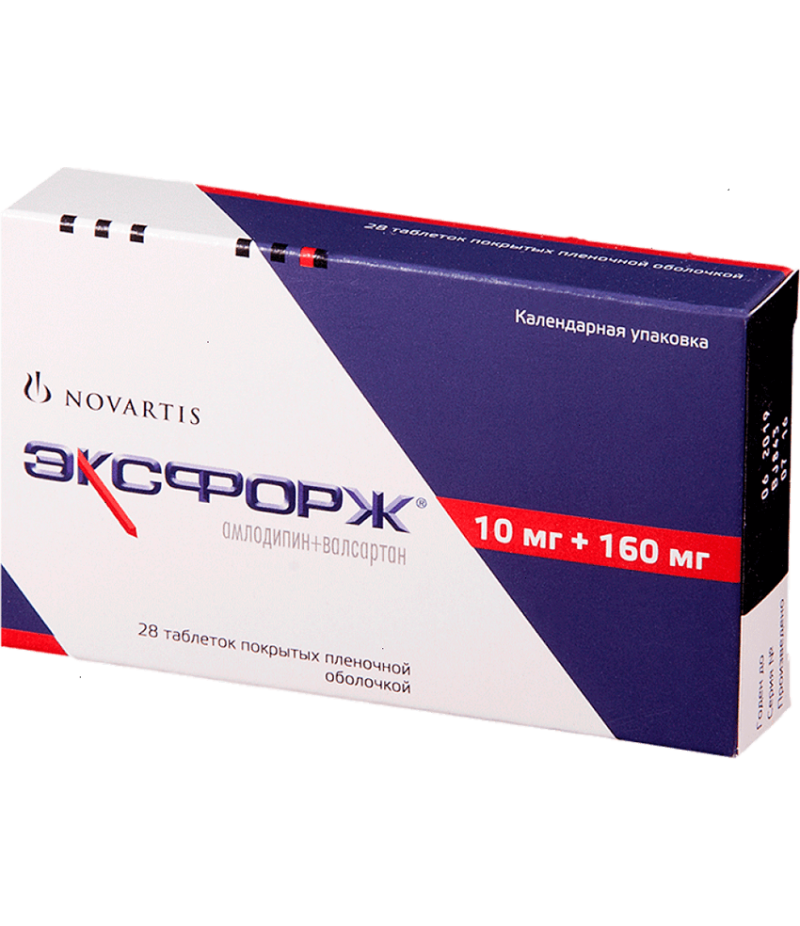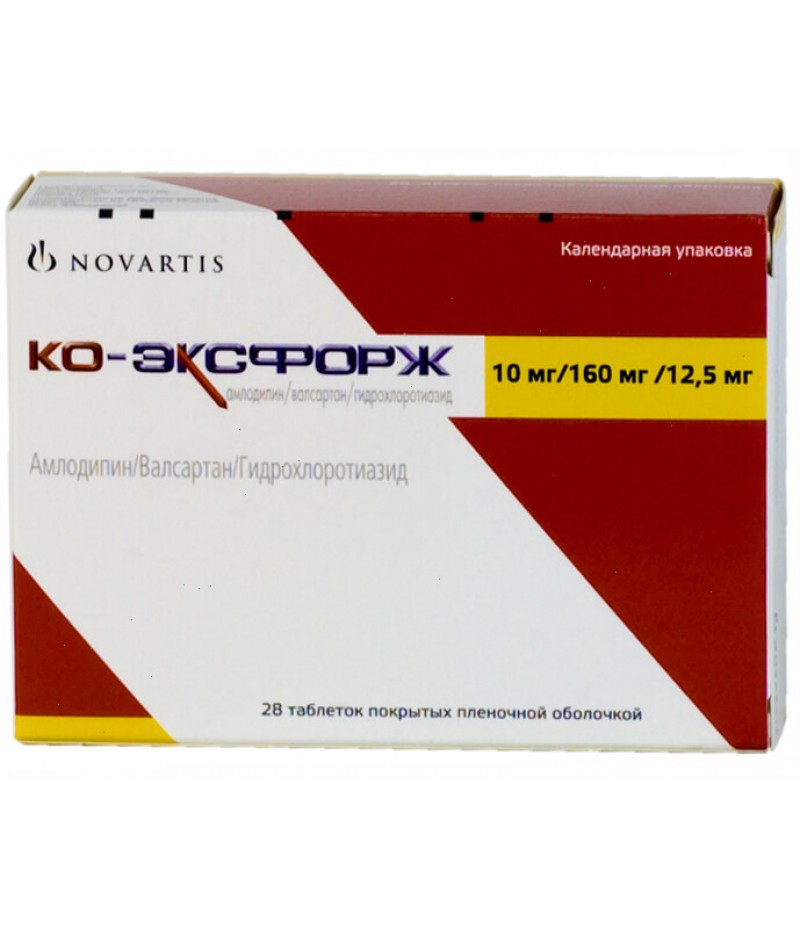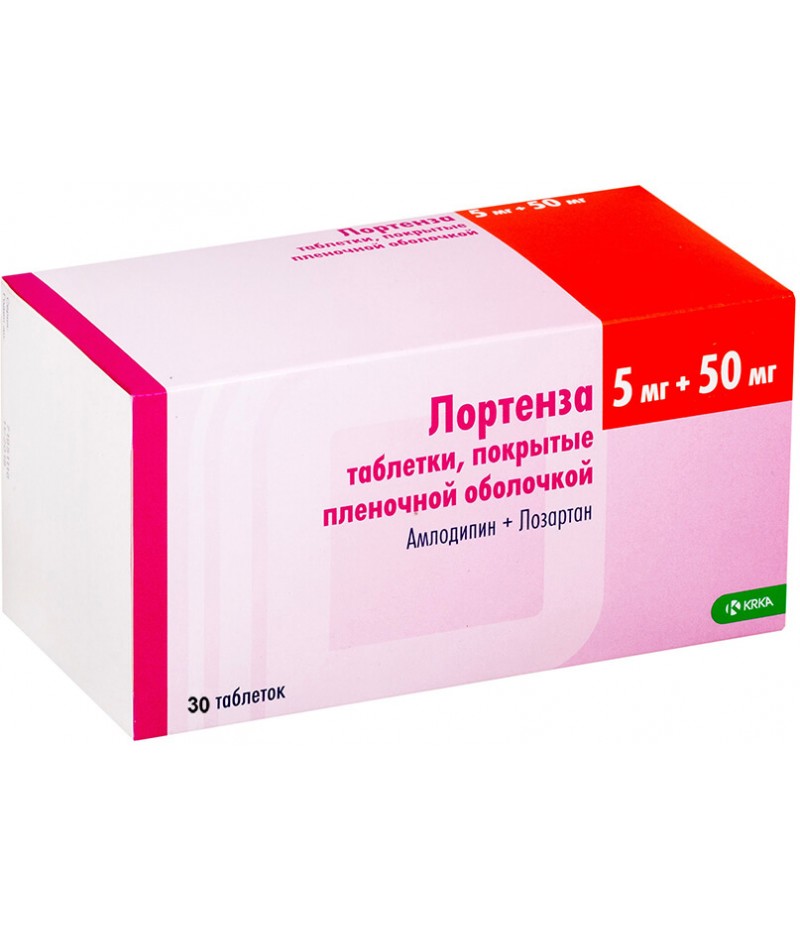Exforge tabs 10mg + 160mg #28
- $65.18
- 2 or more $64.50
- 3 or more $63.87
- Availability:In Stock
Exforge instruction for useYou can buy Exforge tablets hereTo buy Exforge in different forms and dosage just contact usCompositionExforge tablets have active components such as amlodipine and valsartan, as well as the following ad..
Tags: tabs
Exforge instruction for use
You can buy Exforge tablets here
To buy Exforge in different forms and dosage just contact us
Composition
Exforge tablets have active components such as amlodipine and valsartan, as well as the following additional components: talc, MCC, magnesium stearate, hypromellose, silicon colloidal dioxide, titanium dioxide, crospovidone, iron oxide yellow, macrogol 4000.
Co-Exforge, in turn, has the following composition:
active components - amlodipine, valsartan, hydrochlorothiazide;
additional substances: MCC, silicon colloidal dioxide, hypromellose, crospovidone, macrogol, magnesium stearate, titanium dioxide, talc.
Form of issue
Preparations are available in the form of tablets.
pharmachologic effect
Combined antihypertensive drug.
Pharmacodynamics and pharmacokinetics
Active components Exforge have complementary mechanism of action to control blood pressure. Amlodipine belongs to the blockers of the "slow" calcium channels. The second active component of valsartan - refers to angiotensin II receptor antagonists. The combination of these two components has a mutually complementary hypotensive effect, which causes a reduction in arterial (blood pressure).
Amlodipine acts as a relaxing agent on smooth muscle vessels. It expands the walls of the vessels, which causes a decrease in the OPSS and a decrease in blood pressure. With prolonged use, this is not accompanied by significant changes in heart rate and catecholamine content, as well as negative inotropic action.
In people with normal left ventricular function, the drug may cause a slight increase in the cardiac index without a significant effect on the rate of increase in pressure (maximum) in the left ventricle, the volume of the left ventricle and the terminal blood pressure.
The effect of amlodipine is effective in those who have chronic stable and vasospastic angina, as well as angiographically confirmed lesions of the coronary arteries.
Valsartan selectively affects AT1 receptors, blocking them, which can lead to stimulation of AT2 receptors.
With arterial hypertension in those who take valsartan, there is a decrease in blood pressure without changes in heart rate. The antihypertensive effect in this case persists throughout the day. With heart failure (chronic) of II-IV class, the number of hospitalizations decreases. With left ventricular failure or violations of the left ventricle after myocardial infarction, a decrease in cardiovascular mortality is recorded.
The antihypertensive effect after taking the drug becomes noticeable no later than 2 hours later. Decrease in blood pressure to the maximum extent occurs in about 5 hours.
The hypotensive effect is observed more than a day. Reduction of blood pressure to the maximum extent with repeated use can be achieved within 2-4 weeks, it remains at this level with prolonged therapy. If you stop taking valsartan, a sharp increase in blood pressure and other undesirable effects is not observed.
At a dosage of 10/160 mg, the drug normalizes blood pressure values in most patients with inadequate BP control with 10 mg amlodipine.
With the use of dosages of 10/160 and 5/160 mg after application of the drug, blood pressure is normalized in the majority of patients with inadequate control of blood pressure when taking valsartan at 160 mg per day.
Exforge does not depend on age, race or gender.
Pharmacokinetics of this drug is characterized by linearity. After the oral administration of Exforge, the maximum content of amlodipine and valsartan in the plasma is reached after approximately 7 and 3 hours, respectively.
Amlodipine is actively cleaved in the liver, due to which active metabolites are formed. It is withdrawn in two stages with a half-life of 30-50 hours. The equilibrium concentration in the plasma is observed about a week later. 10% of the substance is taken out of their body in an unchanged form and about 60% - in the form of metabolites through the kidneys.
About 20% of a pleasant dose of valsartan is determined in the form of metabolites. The active substance is excreted mainly unchanged through the kidneys and intestines. Half-life is about 6 hours.
Pharmacodynamics of the drug Co-Exforge, in turn, is characterized by the combined effect of the three antihypertensive components, which have a complementary mechanism of action to control blood pressure. In this case, there is a more significant decrease in SAD and DAD, when compared with the use of combinations of only two active substances included in the drug. Target blood pressure indicators are achieved faster.
The maximum antihypertensive effect when taking Co-Exforge can be noticed after 2 weeks from the beginning of the course. The therapeutic effect does not depend on age, race and sex.
The maximum concentration of amlodipine, valsartan and hydrochlorothiazide after taking Co-Exforge appears after 7, 3 and 2 hours, respectively.
Bioavailability of hydrochlorothiazide for oral administration is about 70%. The half-life is 6-15 hours. The substance is excreted in an unchanged form in the urine.
Indications for use
Both drugs are used for hypertension. Exforge is taken by those patients who have been prescribed combined therapy. And Co-Exforge is prescribed at II and III degrees of hypertension.
Contraindications
Exforge is contraindicated in case of individual intolerance of the drug components and pregnancy. With caution, this drug should be taken with liver disease, mitral or aortic stenosis, hyperkalemia, hypertrophic obstructive cardiomyopathy, severe renal impairment, sodium deficiency and / or a decrease in BCC.
Co-Exforge is contraindicated in:
significant violations of the liver;
hypersensitivity to the components of the drug;
refractory to adequate therapy of hypokalemia, hypercalcemia, hyponatremia and hyperuricemia;
pregnancy;
lactation;
significant violations of kidney function;
childhood.
With caution, the drug is taken with:
stenosis of the renal arteries, as well as arteries of a single kidney, mitral or aortic stenosis;
reduction of BCC;
systemic lupus erythematosus;
light and moderate disorders in the liver;
violations of water-electrolyte balance;
hypertrophic obstructive cardiomyopathy;
diabetes mellitus.
Side effects
When taking Exforge, the following side effects are observed:
on the part of the respiratory organs: nasopharyngitis, influenza, cough, pain in the larynx and pharynx;
from the side of the central nervous system: paresthesia, headache, drowsiness, dizziness;
from the CCC: tachycardia, orthostatic hypotension, palpitations;
skin reactions: rash, erythema;
on the part of the digestive system: diarrhea / constipation, abdominal pain, dry mouth, nausea;
from the musculoskeletal system: edema of the joints, arthralgia, back pain;
Other: pastose, peripheral edema, asthenia, flushing of the face, fever, swelling of the face, increased fatigue.
In rare cases: increased sensitivity, visual impairment, marked decrease in blood pressure, tinnitus, anxiety, syncope, hyperhidrosis, pruritus, feeling of heaviness, exanthema, muscle spasms, pollakiuria, erectile dysfunction, polyuria.
In addition, side effects from each of the components can manifest themselves when using Exforge, even if previously not observed in clinical studies.
The drug Co-Exforge has the following side effects:
from the side of metabolism: hypokalemia, anorexia, hyperlipidemia, hyponatremia, hypercalcemia;
from the nervous system: paresthesia, fainting, blocking, dizziness, flavors, headache, coordination disorders, neuropathy;
from the organs of hearing: vertego;
on the part of the respiratory organs: cough, irritation in the throat, dyspnea;
from the skin: itching, increased sweating;
from the kidney and urinary tract: pollakiuria, an increase in creatinine in the plasma, kidney failure;
general disorders: abasia, peripheral edema, fatigue, asthenia, chest pain, gait disturbance, general weakness;
from the side of the psyche: drowsiness, sleep disturbances;
On the part of the organs of vision: visual disturbances;
from the CCC: phlebitis, a significant reduction in blood pressure, orthostatic hypotension, tachycardia, thrombophlebitis;
from the digestive system: indigestion, bad breath in the mouth, abdominal discomfort, diarrhea, dry mouth, vomiting, nausea;
from the musculoskeletal system: pain in the limbs and back, swelling of the joints, muscle spasms, muscle weakness, myalgia;
on the part of the reproductive system: erectile dysfunction;
Other: weight gain, hyperuricemia.
Instructions for use Exforge
Instructions for the use of Exforge provides for its preoral use. The drug is taken once a day, washed down with some water, regardless of the time of meals. Dosages Exforge 10/160, 10/320, 5/80, 5/160, 5/320 mg. The maximum daily dose is 10/320 mg.
For those who have been assigned Co-Exforge, the instruction for use advises to use it once daily in tablets, depending on the doctor's prescription, containing:
5 mg of amlodipine in combination with 160 mg of valsartan and 12.5 mg of hydrochlorothiazide;
10 mg of amlodipine in combination with 160 mg of valsartan and 12.5 mg of hydrochlorothiazide;
10 mg of amlodipine in combination with 320 mg of valsartan and 25 mg of hydrochlorothiazide (2 tablets).
Tablets are taken orally regardless of meals. They must be washed down with water.
Overdose
Valsartan in high doses can lead to a marked decrease in blood pressure and dizziness, and amlodipine - to reflex tachycardia, arterial hypotension, excessive peripheral vasodilation.
Overdose of hydrochlorothiazide is fraught with symptoms that are associated with loss of electrolytes and dehydration. The most likely manifestations: nausea, muscle spasms, cardiac arrhythmia and drowsiness.
As a treatment, induce vomiting or gastric lavage. The reception of activated carbon can help.
With arterial hypotension, the patient needs to take the "lying" position with raised legs, in addition, measures are envisaged to maintain normal CAS work. To normalize blood pressure, you can designate a vasoconstrictor.
Interaction
Clinically significant interaction is not observed when amlodipine is combined with thiazide diuretics, nitroglycerin for sublingual use, ACE inhibitors, warfarin, sildenafil, cimetidine, antibiotics, beta-blockers, long-acting beta-blockers, digoxin, atorvastatin, Maalox, NSAIDs, oral hypoglycemic drugs .
The combination of amlodipine with Diltiazem in patients in old age causes a slowdown in the cleavage of amlodipine, which causes an increase in its plasma content by about half. Together with more powerful inhibitors of CYP3A4, systemic exposure to amlodipine increases.
The combination of amlodipine with inducers of the isoenzyme CYP3A4, on the contrary, leads to a decrease in its concentration. Therefore, it should monitor its content in the plasma.
Clinically significant interaction is absent in the combination of valsartan with cimetidine, Furosemide, Atenolol, Hydrochlorothiazide, Glibenclamide, Warfarin, Digoxin, Indomethacin and Amlodipine.
It is necessary to constantly monitor the potassium concentration while using Exforge together with biologically active additives that contain potassium-sparing diuretics, potassium and potassium-containing salt substitutes, as well as with other agents that cause an increase in the level of potassium in the blood.
When taking Co-Exforge should also take into account the interaction of hydrochlorothiazide with other agents. So you need to monitor the use of this drug in combination with lithium preparations, hypoglycemic drugs for oral use and insulin. It may be necessary to adjust the dosage.
In addition, hydrochlorothiazide potentiates the effect of peripheral muscle relaxants, can cause an increase in the hyperglycemic effect of Diazoxide, increased sensitivity to Allopurinol, an increased risk of developing side effects of Amantadine, a reduction in excretion through the kidney of cytotoxic agents, and their potentiation of myelosuppressive action. In turn, the combination with NSAIDs leads to a decrease in the diuretic and antihypertensive effects of hydrochlorothiazide. Together with drugs that reduce the concentration of potassium, increases the risk of hypokalemia. Cardiac glycosides also increase the risk of its appearance, as well as hypomagnesemia and arrhythmia.
Together with m-holinoblokatorami bioavailability of hydrochlorothiazide increases. When combined with methyldopa, cases of hemolytic anemia have been reported, with Cyclosporine - on the risk of developing hyperuricemia and the development of gout symptoms, with Kabamazepine - hyponatremia, and with vitamin D and calcium salts, an increase in serum calcium is likely. Kolestiramin reduces the absorption of hydrochlorothiazide.
Terms of sale
You can buy Exforge and Co-Exforge without of the doctor's prescription.
Storage conditions
Keep medicines in the reach of small children, dry place. The optimum temperature is not higher than 25 ° C.
Shelf life
The expiration date of Exforge is 2 years, Co-Exforge is 1.5 years.
Reviews about Exforge
Reviews about Exforge have both positive and negative. Many patients note its effectiveness. Some, however, say that they had side effects, because of which it was necessary to cancel the drug.
In fact, no expert can in advance exclude the appearance of undesirable effects. The remedy is much more effective than the use of amlodipine or valsartan alone, but its administration should be well controlled. Many, in addition, it is more profitable to buy analogues Exforge.
Reviews about Co-Exforge are usually positive. Patients note the undoubted effectiveness of this remedy and recommend it to others.



